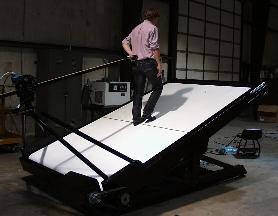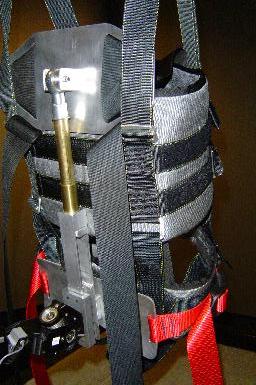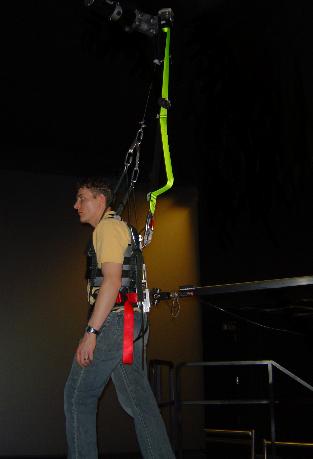|
Locomotion Display |
 The Sarcos Treadport comprises a large tilting treadmill with an
active mechanical tether. The linear treadmill has a
6' by 10' walking surface, and is driven by a belt motor that allows
running at 12 mph and accelerating at 1 g. A hydraulic actuator
tilts the deck in a range of +/- 20 degrees in 1 second. The mechanical
tether measures user position and orientation, which controls treadmill
speed and the user's location in the virtual environment. The tether
attaches to the user through a harness, and can apply horizontal forces
to achieve various effects described below. In addition, there is a
an actuated vertical cable to provide partial weight support.
The Sarcos Treadport comprises a large tilting treadmill with an
active mechanical tether. The linear treadmill has a
6' by 10' walking surface, and is driven by a belt motor that allows
running at 12 mph and accelerating at 1 g. A hydraulic actuator
tilts the deck in a range of +/- 20 degrees in 1 second. The mechanical
tether measures user position and orientation, which controls treadmill
speed and the user's location in the virtual environment. The tether
attaches to the user through a harness, and can apply horizontal forces
to achieve various effects described below. In addition, there is a
an actuated vertical cable to provide partial weight support.
The following locomotion effects are achieved with the active mechanical tether.
- Enforcing unilateral constraints. The mechanical tether will apply a force to prevent people from walking through walls, making the experience more realistic.
- Inertial force display. When people run on a treadmill with constant velocity, there is no difference from ground locomotion. However, when a user accelerates on a treadmill, the body is stationary and there is no f=ma force. With the tether, we can provide an artificial inertial force. Psychophysical experiments show that users prefer this inertial display in comparison to other force control strategies (Christensen et al., 200).
- Slope Display. Treadmill tilt is often too slow to display sudden slope changes. By pulling or pushing on a user, an artificial gravity force can be simulated. Psychophysical experiments show that tether force is a reasonable facsimile for treadmill tilt. In addition, measurements of the leg joint angles while walking on a real slope versus walking on a level slope with tether force showed that the biomechanics are the same (Hollerbach et al., 2001). Energetic measurements confirm a similar level of oxygen consumption (Parker et al., 2005). Uneven terrain such as stair-like slopes can be simulated to a limited extent by shaped tether force pulses (Hayward and Hollebach, 2002).
- Turning. Linear motion of the Treadport's belt requires artificial means for turning control. In the past, we employed a rate-control strategy involving sidestep and body twist, but more recently we showed that a proportional-control strategy involving head gaze with torso trigger yields more accurate maneuvering. (Vijayakar and Hollerbach, 2002).
 A critical
issue is the mechanical coupling of the tether to the body by a
harness. A mechanism-based harness has been designed, which
accomodates the complex motion of the back while reducing backlash and
which allows precise control of the force distribution between
shoulders and hips (Grow and Hollerbach, 2006; Checcacci et al.,
2003). A telescoping joint attaches shoulders to hips. The point of
attachment of the tether to the back can be varied to change the
proportion of the tether force distributed to the shoulders versus
hips.
A critical
issue is the mechanical coupling of the tether to the body by a
harness. A mechanism-based harness has been designed, which
accomodates the complex motion of the back while reducing backlash and
which allows precise control of the force distribution between
shoulders and hips (Grow and Hollerbach, 2006; Checcacci et al.,
2003). A telescoping joint attaches shoulders to hips. The point of
attachment of the tether to the back can be varied to change the
proportion of the tether force distributed to the shoulders versus
hips.
The benefits of 3D force application to the body, rather than just the single axis direction of the current tether, has been evaluated.
- Side force. Pulling from the side can in principle
simulate sideslope walking. Biomechanical similarity has been
established between walking on a sideways tilted platform using ATR's
ATLAS system, and walking on a level treadmill under the influence of
a passive pulley-weight system (Hollerbach et al., 2003).
-
 Vertical force.
A rehabilitation harness has been incorporated into the mechanism-based
harness, in order to provide comfortable support of vertical forces
for extended periods of time (Grow and Hollerbach, 2006). An active
cable winch system has been devised to present supporting vertical
forces. The vertical forces can be used for partial weight support,
in applications such as rehabilitation, reduced gravity environments
such as Mars walking, or steep slope display.
Vertical force.
A rehabilitation harness has been incorporated into the mechanism-based
harness, in order to provide comfortable support of vertical forces
for extended periods of time (Grow and Hollerbach, 2006). An active
cable winch system has been devised to present supporting vertical
forces. The vertical forces can be used for partial weight support,
in applications such as rehabilitation, reduced gravity environments
such as Mars walking, or steep slope display.
Sponsors
The redesign for the second-generation Treadport was supported by the Office of Naval Research Grant N00014-97-1-0355, The Treadport Locomotion Interface for Virtual Worlds, through the Defense University Research Instrumentation Program (Dr. Helen Gigley, Program Officer).Research on the new Treadport was initially funded by an NSF Strategic Grant for Exploratory Research IIS-9908675, Motion Display in the Treadport Locomotion Interface (Dr. Jing Xiao, Program Manager).
Development of treadmill tilt, harness redesign, and biomechanical experiments verifying the locomotion display of slope was supported by an NSF ITR grant IIS-0113996, Advanced Mechanical Displays for Locomotion Interfaces (Dr. Junku Yu, Program Manager).